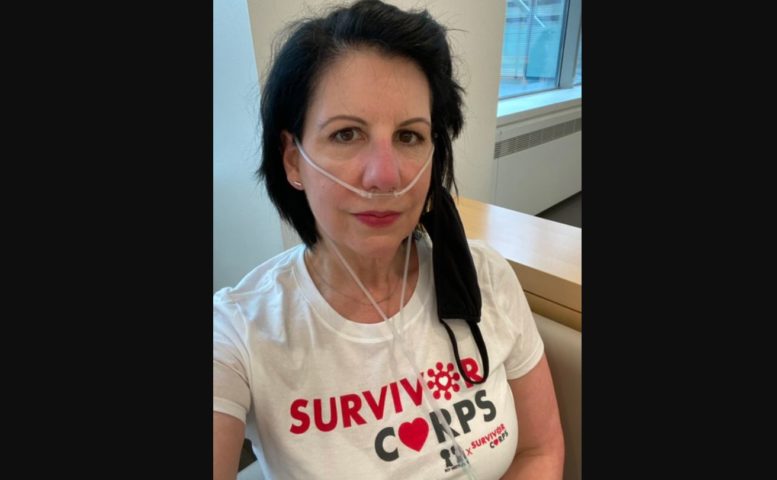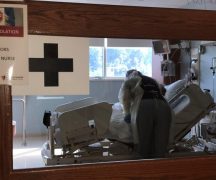When Rachelle Eaton wakes up, her husband needs to help her out of bed.
At a stress test in June, five months after she was diagnosed COVID-19, six minutes of walking on a treadmill caused her blood oxygen to drop to 87%. Eaton, 52, needs to breathe in supplemental oxygen for 20 minutes every other hour.
While general guidelines treat COVID-19 as a disease that runs its course in two weeks, Eaton wrestles with its aftershocks as a “long hauler” — experiencing debilitating symptoms nearly seven months from when she believes she was infected.
Eaton, of Ravenna, is on leave from her accounting job at the Portage County transit authority. She has difficulty conjuring the spelling of her family members’ names, part of an overall “brain fog,” a common sentiment among long haulers. Treasured memories are just out of reach.
“My day is literally just spent getting through the day,” she said. “I cannot drive a car anymore because my brain and my feet and my reflexes, they do not work anymore. So I’m just home. The only time I leave the house is for a doctor’s appointment. And that’s honestly my day. And it really sucks, because I had a really good life.”
Eaton believes she was infected by her boss Jan. 6 after working in close contact putting a spreadsheet together. At first, she thought it was a sinus infection. By Jan. 13, Eaton, an asthmatic, realized it was something worse. On Jan. 19, she went to University Hospital Portage where she was diagnosed with pneumonia as her blood oxygen slid into the 80s.
The hospital sent Eaton home, as all in the UH network did for COVID-19 patients if their blood oxygen saturations were above 80%, according to a spokeswoman.
The virus wasn’t done with her. In time, Eaton’s left lung partially collapsed. She recently learned she has a leaky heart valve and placed appointments on the books with cardiologists and neurologists at a new Cleveland Clinic program for long-haulers. For Eaton and untold others, COVID-19 isn’t a 14-day disease. It’s an ongoing piece of her life, and no doctors can yet answer when the nightmare ends.
Uncertainties abound with what’s called “long COVID.” An analysis of private insurance claims data from the nonprofit FAIR Health analyzed claims from nearly 2 million COVID-19 patients between February 2020 and February 2021. It found 27.5% of symptomatic, non-hospitalized COVID-19 patients reported symptoms more than 30 days after their diagnosis. For hospitalized patients, 50% reported long COVID symptoms.
The five most common post-COVID conditions, from most to least prevalent, were pain, breathing difficulties, hyperlipidemia, malaise/fatigue, and hypertension.
The CDC’s guidance on long-haulers is limited, though the agency lists a dizzying array of reported symptoms ranging from heart palpitations, pins-and-needles feeling, sleep problems, mood changes, and changes in period cycles.
Eaton knows it could be worse. In April 2020, a longtime family friend and cancer survivor died of COVID-19. In January 2021, Eaton contracted COVID-19 the same week as her similar-aged cousin, Wendy Freshwater. They both contracted pneumonias. Freshwater wound up on a ventilator before dying in February.
“Something happened, and she just took a turn,” Eaton said. “That’s COVID. You take two people who are genetically similar. One makes it and one doesn’t.”

Ohio, like other states, has shed its mask mandates. Restaurants, concerts and live sports are back. The hyper-transmissible Delta variant is gaining steam while more than 1 in 2 Ohioans remains unvaccinated against the disease. Eaton, meanwhile, is left to watch from home.
She expressed a sense of fury watching state political leaders echo pieces of anti-vaccine misinformation or even invite high-profile, anti-vaccine influencers to provide legislative testimony at the Statehouse.
For all the rhetoric about how the since-abandoned public health interventions against the pandemic like masks are an assault on “freedom,” Eaton doesn’t feel the liberation.
“To me, freedom is being able to breathe,” she said. “And that has been taken away from me. And it has been taken away from so many people.”
Eaton said last week she’s waiting to hear if her long COVID qualifies her for disability pay, but she’s not hopeful. On Monday, however, President Joe Biden announced that Americans suffering from “long COVID” will have access to benefits and protection provided under federal disability law.
For now, however, all Eaton’s communications to her employer must go through human resources.
Claudia Amrhein, CEO of the Portage Area Regional Transportation Authority, acknowledged in an interview that Eaton required COVID-19 testing around the same time as her boss. However, she said there’s no evidence to show where either employee was infected.
“It’s a worldwide pandemic,” Amrhein said. “A lot of people had it at the same time.”
Eaton said she’s thankful. Her immediate family has supported her around the house, while more distant relatives try to send words of encouragement.
But the optimism is punctuated with the infection’s scars. In an interview, she struggled to recite the spelling of her husband’s name, Steven Lapcevic. Writing it down helped. She keeps a notepad handy with phone numbers, birthdays, and personal notes.
When asked what’s next for her, Eaton said it’s just about keeping her head in the game.
“Part of me has to not give up, and I have to tell myself that every day,” she said. “I have two sons, and they’re only 19 and 20. They think they’re grown, but I still have to tell them what their Social Security numbers are every time they fill out a form. They need me. And I need them. I’m not done with them yet.”
***
Also from Ohio Capital Journal:
In Ohio, COVID-19 on the rise: ‘We think the delta variant is the dominant one’
With fewer than 1 in 2 Ohioans vaccinated, public health data shows COVID-19 is once again ascendant in Ohio as immunizations slow and a hyper-transmissible variant proliferates.
More than 700 Ohioans are hospitalized as of Monday with COVID-19 — a far cry from hellacious peaks above 5,000 from last winter, but a 163% increase over the last three weeks, according to data from the Ohio Hospital Association.
On Friday, 929 Ohioans contracted COVID-19, a fourfold increase from early July, according to an analysis of data from the Ohio Department of Health. More than five in 100 COVID-19 tests taken in Ohio are yielding positive results, up from one in 100 in early July. READ MORE
Commentary: COVID-19 could cause male infertility & sexual dysfunction – but vaccines do not
Contrary to myths circulating on social media, COVID-19 vaccines do not cause erectile dysfunction and male infertility.
What is true: SARS-CoV-2, the virus that causes COVID-19, poses a risk for both disorders.
Until now, little research has been done on how the virus or the vaccines affect the male reproductive system. But recent investigations by physicians and researchers here at the University of Miami have shed new light on these questions.
The team, which includes me, has discovered potentially far-reaching implications for men of all ages – including younger and middle-aged men who want to have children. READ MORE





